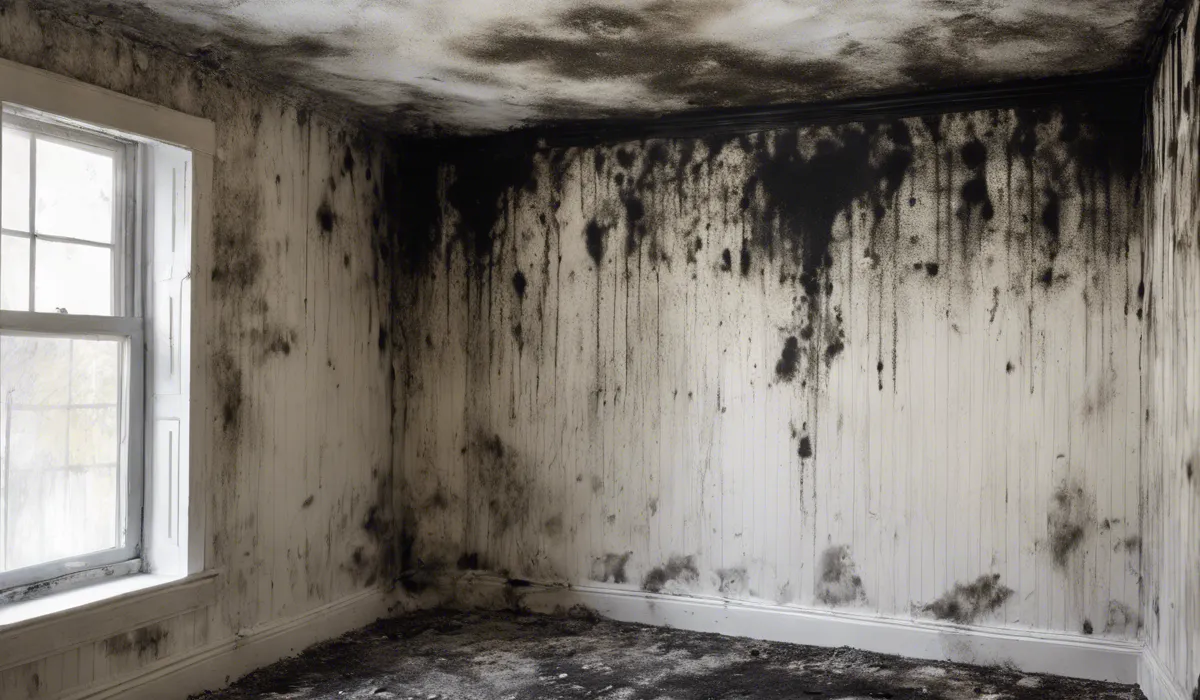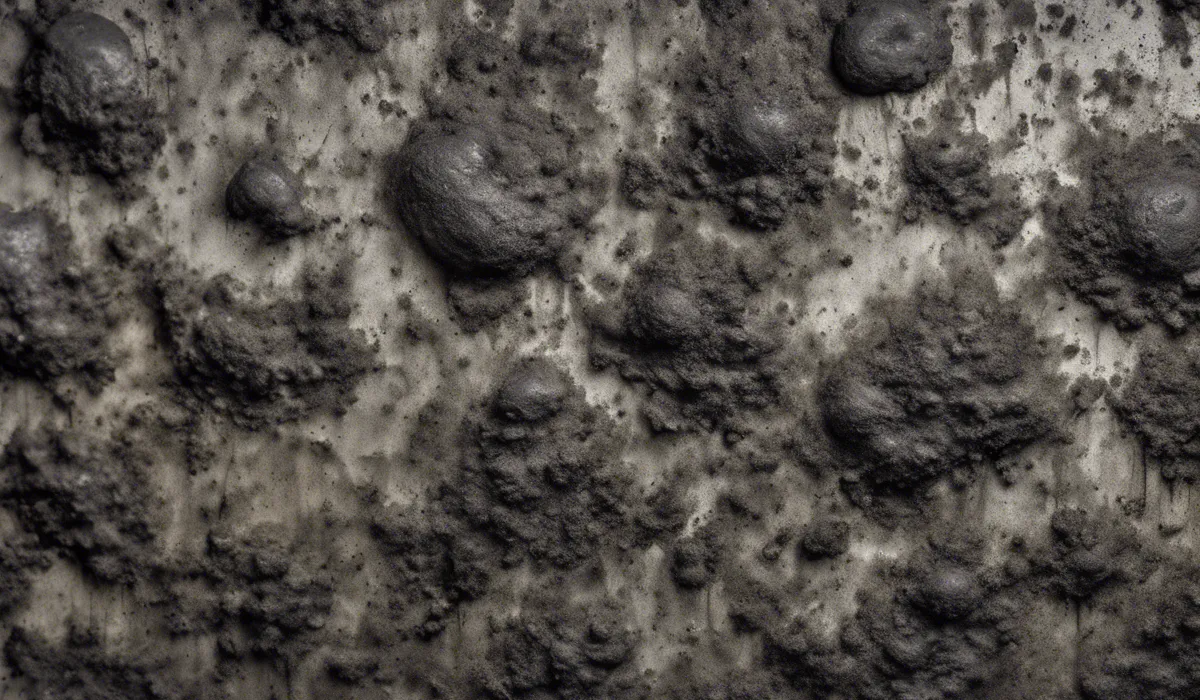Any amount of black mold can be dangerous, as it produces toxins that may cause health issues, especially in sensitive individuals. Immediate removal and remediation are recommended upon detection to minimize risks.
Understanding Black Mold and Its Health Implications

What Is Black Mold?
Black mold, scientifically known as Stachybotrys chartarum, is a type of fungus that thrives in damp, warm, and humid conditions.
It appears as a dark green or black gelatinous growth, often accompanied by a distinctive musty odor.
This type of mold can grow on a variety of materials such as wood, paper, and textiles, especially when they are exposed to moisture for prolonged periods.
Black Mold’s Toxic Secret
Mycotoxins are poisonous substances produced by certain kinds of molds, including black mold.
These toxins can cause a range of health issues when humans are exposed to them, either through inhalation, ingestion, or skin contact.
The specific type of mycotoxins produced by black mold can be particularly harmful, which is why it’s important to manage mold growth in your living spaces.
Health Risks of Black Mold Exposure
Exposure to black mold can lead to various health problems. Common symptoms include respiratory issues, such as coughing and wheezing, skin irritation, allergic reactions, and headaches.
In severe cases, it can exacerbate asthma and lead to more serious conditions like pulmonary hemorrhage or memory loss. Understanding these risks is crucial for protecting your health and the health of those around you.
Who Is at Risk?
While black mold can affect anyone, certain individuals are more vulnerable to its adverse health effects.
These include infants, the elderly, people with compromised immune systems, those with pre-existing respiratory conditions, and those with allergies to mold. It’s essential to be vigilant about mold prevention and remediation to protect these at-risk groups.
Assessing Mold Exposure and Potential Dangers

Spotting Black Mold in Your Surroundings
Identifying black mold involves looking for tell-tale signs such as dark spots on walls, ceilings, or floors, a musty odor, and even health symptoms among inhabitants that may suggest mold-related issues.
It’s important to regularly inspect areas prone to moisture, like bathrooms, kitchens, and basements, to catch any mold growth early.
Understanding the Factors of Mold Danger
The danger level of black mold depends on several factors. The amount of mold present is significant – the more mold, the higher the concentration of mycotoxins, which increases the health risk.
The location of the mold growth matters, as mold in ventilation systems can spread spores throughout a building.
Additionally, the duration of exposure can greatly affect health outcomes; longer exposure can lead to more severe symptoms.
Recognizing Symptoms of Black Mold Exposure
Be aware of symptoms that may indicate black mold exposure, such as persistent coughing, sneezing, eye irritation, skin rash, or chronic fatigue.
If you or someone in your household is experiencing these symptoms and you suspect mold may be the cause, it’s important to act quickly to address the issue.
When Is Black Mold Too Much?
Any amount of black mold can be harmful, especially to sensitive individuals. It’s not about finding a safe level; it’s about immediate action.
If you discover black mold in your home or workplace, consider it a health risk that requires prompt attention and remediation.
Prevention and Remediation of Black Mold

Preventing Black Mold Growth
Preventing black mold begins with controlling moisture in your environment. Fix leaks, dry wet areas immediately, and use dehumidifiers in damp spaces.
Regular household cleaning can also help prevent mold spores from taking hold and growing into a larger problem.
Key to Prevention
Maintaining low humidity levels and good air circulation is vital to prevent mold growth. Ventilation systems should be kept clean, and exhaust fans should be used in bathrooms and kitchens.
Ensure your home or workplace has proper drainage and that water does not accumulate near the foundation.
Guidelines for Safe Mold Removal
If you find mold, small areas can often be cleaned with soap and water, or a bleach solution recommended by health agencies.
However, it’s important to wear protective gear, such as gloves and masks, to avoid exposure to mold spores during cleanup.
When to Call the Professionals?
For large mold infestations, or if the mold returns after initial cleaning, it’s best to call in professional mold remediators.
They have the expertise and equipment to safely and effectively remove mold from your environment.
Maintaining a Mold-Free Environment
Long-term strategies to keep your home or workplace mold-free include regular inspections, maintaining good air quality, and quickly addressing any water damage.
Educating yourself and others on the risks and prevention of black mold will help ensure a healthier living and working environment.
FAQs About Black Mold Danger Levels
Is any amount of black mold considered dangerous?
Yes, any amount of black mold is considered dangerous as it can produce harmful toxins.
What health issues can black mold cause?
Black mold can cause various health issues including respiratory problems, allergic reactions, and in severe cases, neurological problems, particularly in sensitive individuals.
Should I remove black mold immediately upon detection?
Yes, immediate removal and remediation of black mold are recommended to minimize health risks.
Are some people more sensitive to black mold than others?
Yes, individuals with allergies, respiratory conditions, or compromised immune systems may be more sensitive to the effects of black mold.
Can black mold grow back after removal?
Black mold can regrow if the underlying moisture problem that allowed it to flourish initially is not properly addressed.
Final Thoughts
Black mold poses a health risk at any level of exposure, especially for those with sensitivities.
It produces harmful toxins that can lead to various health issues. To safeguard health, it is crucial to act swiftly by removing and remediating black mold as soon as it’s detected.
